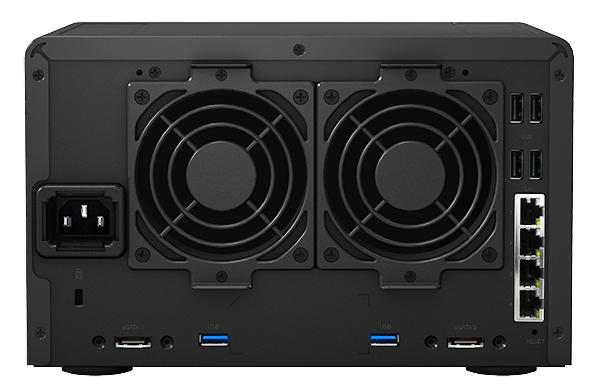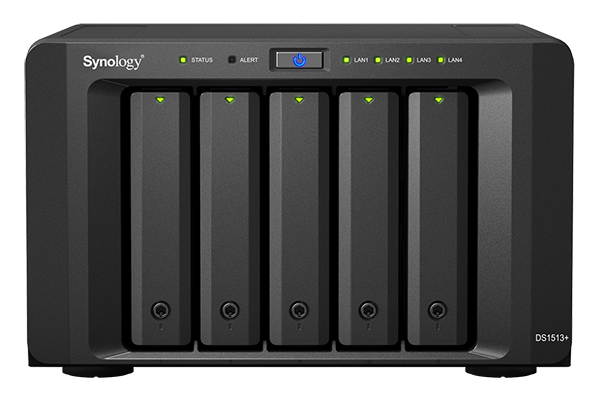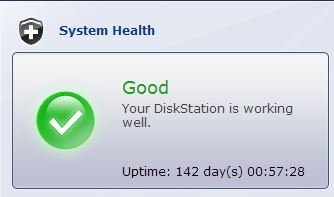Today Synology is releasing the DS1513+ NAS unit. The Synology DS1513+ is a 5-bay NAS unit from Synology that brings additional features to the DS1512+ one of the most notable of which is quad gigabit Ethernet. The rear of the Synology DS1513+ has two fans. Synology has a feature that if one fan fails, the other will spin faster under load until the failed fan is replaced. Along with the dual fans, one can see four USB 2.0 ports and two USB 3.0 ports. eSATA connectivity allows one to expand the unit with DX513 SATA port multiplier units. This allows the Synology DS1513+ to access up to 15 drives (or 60TB.) One of the biggest changes one will see versus the DS1512+ is the quad gigabit NIC in the rear. This supports features such as link aggregation, failover and Synology High-Availability. For STH readers, this may be a really interesting feature as it increases the bandwidth available from the DS1513+.

The front of the unit is fairly straightforward. The Synology DS1513+ holds five bays and has status LEDs for each of the four LAN ports. It appears as though the units are still using 2.13GHz Intel Atom processors which work well in this class of device.

Synology DSM 4.2 comes standard on the Synology DS1513+. We upgraded from DSM 4.1 to DSM 4.2 shortly after the release. At the time of the upgrade, the Synology unit had 142 days of uptime without a hiccup. During the 142 days the Synology DS1812+ served iSCSI to Hyper-V and iSCSI servers, managed photo storage, and performed hundreds of OS installs from the unit. DSM 4.2 already has racked up over a month of uptime. Suffice to say, Synology is putting stability as a key capability of their DSM software found on the DS1513+ and DS1512+. One interesting feature is SHA (Synology High Availability.) SHA provides a HA solution to the SMB market for those customers with two Synology units.

[toggle_box title=”Toggle for Synology DS1513+ Quick Specs” width=”Width of toggle box”]
- CPU Frequency : Dual Core 2.13GHz
- Floating Point
- Memory : DDR3 2GB
- Internal HDD/SSD : 3.5″ or 2.5″ SATA(II) X 5 (Hard drive not included)
- Max Internal Capacity : 20TB (5 X 4TB HDD) (Capacity may vary by RAID types)
- Hot Swappable HDD
- External HDD Interface : USB 3.0 Port X 2, USB 2.0 Port X 4, eSATA Port X 2
- Size (HxWxD) : 157 X 248 X 233 mm
- Weight : 4.25Kg
- LAN : Gigabit X 4
- Link Aggregation
- Wake on LAN/WAN
- System Fan : 80x80mm X2
- Easy Replacement System Fan
- Wireless Support (dongle)
- Noise Level : 22.1 dB(A)
- Power Recovery
- AC Input Power Voltage : 100V to 240V AC
- Power Frequency : 50/60 Hz, Single Phase
- Power Consumption : 51W (Access); 25.75W (HDD Hibernation);
- Operating Temperature : 5°C to 35°C (40°F to 95°F)
- Storage Temperature : -10°C to 70°C (15°F to 155°F)
- Relative Humidity : 5% to 95% RH
- Maximum Operating Altitude : 6,500 feet
- Certification : FCC Class B, CE Class B, BSMI Class B
- Warranty : 3 Years
Check out the full spec sheet at Synology.com here.
[/toggle_box]





How much power (watts) does it use at idle and at 100% utilization @ 120V?
Hi ion21 – Synology specs are in the drop down toggle:
Power Consumption : 51W (Access); 25.75W (HDD Hibernation);
Hey Pat, whats the real gains in in having quad-ports when it is only smaller product on the market (of Synology’s) and is still running on the lower end of the hardware specs.
Redundancy can be done with just two, multiple IP’s to hardware ports maybe, aggregation isn’t mentioned and as I mentioned, can’t see the point as the speed of this unit is not going to max out more than two ports.
I have seen the Synology DS1812+ push out over 200MB/s over two links. My sense is that you could easily get over 300MB/s from these units. Having four NICs is not all about speed though. It also allows one to put two links to two different switches for example.
If you look at the specs it shows that it can: 202.34 MB/sec Writing, 350.94MB/sec Reading